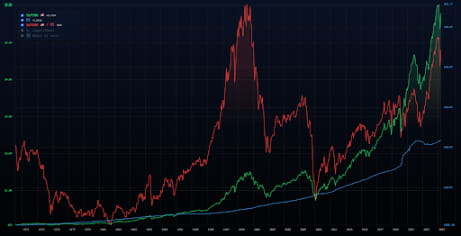Written by: Level
Compiled by: AididiaoJP, Foresight News
Stablecoins are reshaping the underlying architecture of the global financial system. As a new type of digital asset, their core value manifests in three dimensions: the programmability at the technical level allows them to be embedded in smart contracts for automatic execution; the borderless nature at the geographic level breaks traditional finance's regional barriers; and the high-speed efficiency at the efficiency level reduces settlement time from the traditional T+1 or even T+3 to nearly real-time.
However, beyond payment functions, stablecoins are quietly enhancing currency circulation speed: changing the frequency of use of each dollar, the direction of flow, and stimulating the speed of economic activity. The impact of stablecoins on currency circulation speed presents a unique 'double helix' effect: on one hand, automated clearing through smart contracts releases idle settlement margins in traditional finance; on the other hand, 24/7 uninterrupted global liquidity pools significantly improve capital turnover efficiency, particularly evident in cross-border B2B transactions.
This phenomenon is reminiscent of the transformation brought about by the internet on early forms of currency and value exchange two decades ago. Electronic payments primarily optimized payment efficiency, while stablecoins have restructured the complete loop of value storage, transfer, and creation on the basis of efficiency improvements. To understand the current role of stablecoins, we need to return to the fundamental concepts.

Note: The 2024 Chainalysis Global Cryptocurrency Adoption Index ranks 151 countries based on four sub-indicators that measure the usage of different cryptocurrency services. The ranking results are adjusted for population and purchasing power parity, averaged, and normalized to a range of 0-1. The data is based on estimates of transaction volumes from cryptocurrency service website traffic and cross-verified with surveys from local experts.
Definition of currency circulation speed
Currency circulation speed refers to the rate at which money is exchanged within an economy, usually calculated by the following formula:
Circulation speed = Gross Domestic Product (GDP) / Money Supply
It measures the production efficiency of each unit of currency. High circulation speed indicates that money is frequently used to purchase goods and services; low circulation speed suggests that money is being saved or idle.
However, 'money' is not a singular concept. Economists categorize it into different levels:
M1: Cash + demand deposits, the most liquid form of money.
M2: M1 + savings accounts + time deposits under $100,000 + money market funds.
M3 (no longer used in the U.S.): M2 + large time deposits + institutional money market funds + other large-scale financial instruments.
Fully backed by fiat currency and redeemable at any time, stablecoins behave similarly to M1: extremely liquid and usable instantly.
Fluctuations in the speed of currency circulation in the Internet age
From the late 1990s to the early 21st century, the rise of the internet significantly increased the speed of currency circulation:
E-commerce has achieved a comprehensive upgrade in consumption.
Email has accelerated transactions and contract signing.
Globalization of market access.
Digital banking has made money more liquid.
This early efficiency improvement drove the growth of M1 circulation speed.
However, as the internet matures, another trend has taken the lead:
Capital appreciation creates immense wealth.
This wealth is saved and invested in stocks, bonds, and real estate.
More funds are used for investment rather than consumption.
Circulation speed slows, but GDP continues to grow, as capital formation gradually replaces purely consumption activities.

M3 money supply and the historical growth trend of the S&P 500 index
How stablecoins enhance global currency circulation speed
Today, stablecoins are introducing similar dynamics: they significantly enhance the speed, accessibility, and availability of money. However, unlike the early internet, this transformation is global from the start. Here are the specific manifestations:
1. 24/7 borderless transfers
In the field of cross-border payments, stablecoins enable 24/7 instant settlement. Issuers like Circle and Tether have built a global payment network, allowing fund transfers to no longer be constrained by traditional banking hours and cross-border limitations. This efficiency improvement is particularly significant in the remittance market, where traditional cross-border remittances that take 3-5 business days can be completed in minutes using stablecoins.
2. On-chain finance and DeFi
The development of decentralized finance (DeFi) further amplifies the economic value of stablecoins. On platforms like Aave and Compound, stablecoin holders can participate in lending markets, turning idle funds into productive capital. This improvement in fund utilization efficiency directly promotes the acceleration of currency circulation speed, with platforms like Morpho Labs and Pendle allowing users to use stablecoins for lending, yield products, or liquidity provision.
3. Remittances and payments
APIs developed by startups like Stablecoin enable businesses to integrate stablecoin payments into existing cash flows, while supporting global instant settlement around the clock, reducing foreign exchange costs, and reaching markets that traditional finance struggles to cover.
Another example is cryptocurrency debit cards, which allow users to directly use their on-chain stablecoin balances for daily purchases. By connecting with major payment networks like Visa and Mastercard, these cards instantly convert stablecoins to local currency at the time of purchase, without additional exchange. This bridge between on-chain and the real world makes stablecoins an active medium of exchange for purchasing daily necessities, travel, and other everyday needs, thereby enhancing global currency circulation speed.
4. Permissionless access to dollars
In countries like Turkey, Argentina, and Nigeria, stablecoins serve as an important financial tool, allowing users to store dollar value and trade freely with just a mobile phone and internet connection. By reducing reliance on intermediaries and achieving instant, borderless payments, stablecoins more efficiently activate the efficiency of local funds and include more participants in the economic system.
For small and medium-sized enterprises (whether in manufacturing, agriculture, digital services, or local retail), stablecoins enable direct connections between international buyers and suppliers, reducing friction in cross-border trade, eliminating settlement delays, and protecting businesses from sudden depreciation of local currency. Stablecoins allow individuals and businesses to maintain capital circulation within the local economy, which not only accelerates currency circulation speed but also enhances economic resilience in high-volatility currency environments.
Practices of stablecoins in Southeast Asia
In developing markets like Thailand, Vietnam, and the Philippines, the adoption of stablecoins is accelerating through P2P and over-the-counter trading channels. For example, Thailand's Siam Commercial Bank (SCB) collaborates with Lightnet through its innovative unit SCB 10X to enable cross-border payments and remittances using stablecoins on a public blockchain. This is Thailand's first stablecoin-based settlement case, setting a benchmark for the regional financial industry. By integrating Fireblocks' custody infrastructure, the service ensures institutional-level asset security and enhances trust among all parties. In the future, SCB and Lightnet plan to expand services to corporate clients for two-way remittances and provide the same efficiency and cost advantages to retail users.

Euromonitor mobile payment data
Short-term impact: Improvement of economic efficiency
In the short term, the increase in currency circulation speed driven by stablecoins has brought significant economic benefits:
GDP growth: Faster circulation of the same capital pool promotes economic activity.
Increased productivity: Instant, low-friction payments and faster working capital cycles optimize business efficiency.
Enhanced financial inclusivity: Gig economy workers, creators, and merchants can trade using stable dollar assets without relying on traditional banks.
This releases long-suppressed economic potential in emerging markets. Just as the early internet accelerated business development by eliminating friction in communication and distribution, stablecoins are doing the same for value transfer, allowing funds to flow freely, around the clock, and at almost zero cost.
Long-term impact: From speed to scale
The long-term effects are more complex.
As users in emerging markets gain access to dollars and stablecoins, some capital is not used for consumption but is saved or invested:
Staked in DeFi for passive income.
Used to purchase assets (real estate, tokens, stocks).
Reserved for business expansion.
These actions remove funds from the short-term trading cycle, reducing local circulation speed. However, this is not a negative outcome. Similar to the early 21st century, it reflects a shift from speed-driven consumption to wealth accumulation and capital formation, which is a sign of economic maturity.
Even as the turnover frequency of money decreases, its utilization efficiency is higher. In the early growth stage, emerging economies tend to consume, focusing on infrastructure development and catching up with developed economies. As income rises and financial tools become more popular, savings rates gradually increase, and households begin to accumulate wealth and invest in long-term assets. Stablecoins can accelerate this transformation.
Conclusion
Stablecoins are changing the way global funds flow, enhancing transaction speed while deepening financial inclusivity. They are short-term boosters of circulation speed and long-term builders of capital formation.
Currency circulation speed, as a key indicator of economic vitality, is calculated as the ratio of GDP to money supply. The emergence of stablecoins has injected new connotations into this traditional economic concept. Fully backed by fiat currency and redeemable at any time, stablecoins exhibit liquidity characteristics similar to M1 money, but their operational efficiency far exceeds that of traditional fiat.
It is important to note that circulation speed does not operate in isolation; its economic impact depends on the following factors:
Interest rates: High interest rates encourage saving, reducing circulation speed.
Inflation expectations: If prices are expected to rise, people will accelerate consumption.
Tariffs and capital controls: These may restrict the use of stablecoins in certain regions.
Fiscal policy: Government transfers, taxes, and subsidies all affect currency circulation.
Nevertheless, the result is the birth of a new type of global economic form: stablecoins can flow instantly, settle automatically, and remain robust in development. Just as the early internet reshaped communication and commerce, stablecoins are doing the same to money itself. This transformation is not about printing more money, but about utilizing existing resources more efficiently.
